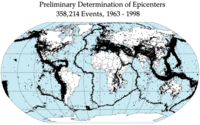
Photo from wikipedia
The frictional instability associated with earthquake initiation and earthquake dynamics is believed to be mainly controlled by the dynamics of fragmented rocks within the fault gauge. Principal features of the… Click to show full abstract
The frictional instability associated with earthquake initiation and earthquake dynamics is believed to be mainly controlled by the dynamics of fragmented rocks within the fault gauge. Principal features of the emerging seismicity (e.g., intermittent dynamics and broad time and/or energy scales) have been replicated by simple experimental setups, which involve a slowly driven slider on top of granular matter, for example. Yet these setups are often physically limited and might not allow one to determine the underlying nature of specific features and, hence, the universality and generality of the experimental observations. Here, we address this challenge by a numerical study of a spring-slider experiment based on two-dimensional discrete element method simulations, which allows us to control the properties of the granular matter and of the surface of the slider, for example. Upon quasistatic loading, stick-slip-type behavior emerges which is contrasted by a stable sliding regime at finite driving rates, in agreement with experimental observations. Across large parameter ranges for damping, interparticle friction, particle polydispersity, etc., the earthquake-like dynamics associated with the former regime results in several robust scale-free statistical features also observed in experiments. At first sight, these closely resemble the main empirical relations of tectonic seismicity at geological scales. This includes the Gutenberg-Richter distribution of event sizes, the Omori-Utsu-type decay of aftershock rates, as well as the aftershock productivity relation and broad recurrence time distributions. Yet, we show that the correlations associated with tectonic aftershocks are absent such that the origin of the Omori-Utsu relation, the aftershock productivity relation, and Båth's relation in the simulations is fundamentally different from the case of tectonic seismicity. This, we believe, is mainly due to a lack of macroscale relaxation processes that are closely tied to the generation of real aftershocks. We argue that the same is true for previous laboratory experiments.
Journal Title: Physical review. E
Year Published: 2022
Link to full text (if available)
Share on Social Media: Sign Up to like & get
recommendations!